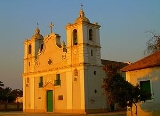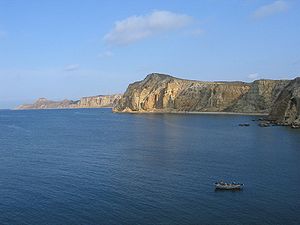
Benguela
Encyclopedia
Benguela is a city in western Angola
, south of Luanda
, and capital of Benguela Province. It lies on a bay of the same name, in 12° 33’ S., 13° 25’ E. Benguela is one of Angola's most populous cities.
under Manuel Cerveira Pereira, 8th Governor
of Angola (1604-1607). It was long the centre of an important trade, especially in slaves
to Brazil
and Cuba
. Ships anchor about a mile off the shore, in 4 to 6 fathom
s (7 to 11 m) and transfer loads to smaller boats which use five or six jetties
in the town. However the nearby deep-water sheltered harbour of Lobito
is a much larger port.
.svg.png) Besides the churches of S. Felipe and S. Antonio, the hospital, and the fortress, there were, as of 1911, only a few stone-built houses. A short way beyond Benguela is Baía Farta, where salt was manufactured and sulphur was extracted. Close to Baia Farta was the most beautiful beach of Baia Azul
Besides the churches of S. Felipe and S. Antonio, the hospital, and the fortress, there were, as of 1911, only a few stone-built houses. A short way beyond Benguela is Baía Farta, where salt was manufactured and sulphur was extracted. Close to Baia Farta was the most beautiful beach of Baia Azul
. The city prospered and grew in the following decades. The Benguela Railway was built in the early 20th century by Portugal to connect the city and Lobito
to the interior, and it achieved great success when linked to the Copperbelt of Katanga
, DR Congo and Zambia
. Starting in the early 20th century, Benguela attracted, developed, and retained quality businesses and professionals into its thriving and growing economy. Sisal
and fishing
industries expanded and the financial, construction and services market boomed until 1974.
in Lisbon
, Portugal, the Portuguese Overseas Province of Angola became independent. Due to the civil war in Angola
(1975-2002), which lasted more than 20 years after independence from Portugal, the important Benguela railway line closed, with only the short distance of 30 km between Benguela and Lobito
remaining operational. In the mid-2000s, with a more peaceful environment, rehabilitation of the railway between Benguela and Huambo
commenced.
In 1983 Benguela had a population of 155,000. During the civil war the city of Benguela increased its population due to refugees from the countryside. While the colonial part of the city consists of relatively good-quality houses, most of the refugees live in slum areas.

Angola
Angola, officially the Republic of Angola , is a country in south-central Africa bordered by Namibia on the south, the Democratic Republic of the Congo on the north, and Zambia on the east; its west coast is on the Atlantic Ocean with Luanda as its capital city...
, south of Luanda
Luanda
Luanda, formerly named São Paulo da Assunção de Loanda, is the capital and largest city of Angola. Located on Angola's coast with the Atlantic Ocean, Luanda is both Angola's chief seaport and its administrative center. It has a population of at least 5 million...
, and capital of Benguela Province. It lies on a bay of the same name, in 12° 33’ S., 13° 25’ E. Benguela is one of Angola's most populous cities.
Portuguese rule
Benguela, a Portuguese fort from 1587, was founded in 1617 by the PortuguesePortugal
Portugal , officially the Portuguese Republic is a country situated in southwestern Europe on the Iberian Peninsula. Portugal is the westernmost country of Europe, and is bordered by the Atlantic Ocean to the West and South and by Spain to the North and East. The Atlantic archipelagos of the...
under Manuel Cerveira Pereira, 8th Governor
Governor
A governor is a governing official, usually the executive of a non-sovereign level of government, ranking under the head of state...
of Angola (1604-1607). It was long the centre of an important trade, especially in slaves
Slavery in Angola
Slavery in Angola existed since early times. Several peoples and tribes from current-day Angola, like the Imbangala and the Mbundu, were active slave traders for centuries...
to Brazil
Brazil
Brazil , officially the Federative Republic of Brazil , is the largest country in South America. It is the world's fifth largest country, both by geographical area and by population with over 192 million people...
and Cuba
Cuba
The Republic of Cuba is an island nation in the Caribbean. The nation of Cuba consists of the main island of Cuba, the Isla de la Juventud, and several archipelagos. Havana is the largest city in Cuba and the country's capital. Santiago de Cuba is the second largest city...
. Ships anchor about a mile off the shore, in 4 to 6 fathom
Fathom
A fathom is a unit of length in the imperial and the U.S. customary systems, used especially for measuring the depth of water.There are 2 yards in an imperial or U.S. fathom...
s (7 to 11 m) and transfer loads to smaller boats which use five or six jetties
Jetty
A jetty is any of a variety of structures used in river, dock, and maritime works that are generally carried out in pairs from river banks, or in continuation of river channels at their outlets into deep water; or out into docks, and outside their entrances; or for forming basins along the...
in the town. However the nearby deep-water sheltered harbour of Lobito
Lobito
Lobito is a town and municipality in Benguela Province in Angola.It dates from 1905 and owes its existence to the bay of the same name having been chosen as the sea terminus of the Benguela railway to the far interior, passing through Luau to Katanga in the Democratic Republic of the Congo. The...
is a much larger port.
.svg.png)
Baía Azul
Baía Azul is a beach in the south of Benguela Province in Angola. It is situated south of Praia Morena beach. It owes its name to the blue waters that glisten from a light green to a navy blue. Baía Azul is considered "the mother" of the beaches in Benguela. Its unique and incomparable beauty and...
. The city prospered and grew in the following decades. The Benguela Railway was built in the early 20th century by Portugal to connect the city and Lobito
Lobito
Lobito is a town and municipality in Benguela Province in Angola.It dates from 1905 and owes its existence to the bay of the same name having been chosen as the sea terminus of the Benguela railway to the far interior, passing through Luau to Katanga in the Democratic Republic of the Congo. The...
to the interior, and it achieved great success when linked to the Copperbelt of Katanga
Katanga Province
Katanga Province is one of the provinces of the Democratic Republic of the Congo. Between 1971 and 1997, its official name was Shaba Province. Under the new constitution, the province was to be replaced by four smaller provinces by February 2009; this did not actually take place.Katanga's regional...
, DR Congo and Zambia
Zambia
Zambia , officially the Republic of Zambia, is a landlocked country in Southern Africa. The neighbouring countries are the Democratic Republic of the Congo to the north, Tanzania to the north-east, Malawi to the east, Mozambique, Zimbabwe, Botswana and Namibia to the south, and Angola to the west....
. Starting in the early 20th century, Benguela attracted, developed, and retained quality businesses and professionals into its thriving and growing economy. Sisal
Sisal
Sisal is an agave that yields a stiff fibre traditionally used in making twine, rope and also dartboards. The term may refer either to the plant or the fibre, depending on context...
and fishing
Fishing in Angola
Fishing in Angola is mainly performed by foreign fleets. Some of the foreign fishing fleets operating in Angolan waters were required by the government to land a portion of their catch at Angolan ports to increase the local supply of fish...
industries expanded and the financial, construction and services market boomed until 1974.
After independence from Portugal
In 1975, after the April 1974 Carnation RevolutionCarnation Revolution
The Carnation Revolution , also referred to as the 25 de Abril , was a military coup started on 25 April 1974, in Lisbon, Portugal, coupled with an unanticipated and extensive campaign of civil resistance...
in Lisbon
Lisbon
Lisbon is the capital city and largest city of Portugal with a population of 545,245 within its administrative limits on a land area of . The urban area of Lisbon extends beyond the administrative city limits with a population of 3 million on an area of , making it the 9th most populous urban...
, Portugal, the Portuguese Overseas Province of Angola became independent. Due to the civil war in Angola
Angolan Civil War
The Angolan Civil War was a major civil conflict in the Southern African state of Angola, beginning in 1975 and continuing, with some interludes, until 2002. The war began immediately after Angola became independent from Portugal in November 1975. Prior to this, a decolonisation conflict had taken...
(1975-2002), which lasted more than 20 years after independence from Portugal, the important Benguela railway line closed, with only the short distance of 30 km between Benguela and Lobito
Lobito
Lobito is a town and municipality in Benguela Province in Angola.It dates from 1905 and owes its existence to the bay of the same name having been chosen as the sea terminus of the Benguela railway to the far interior, passing through Luau to Katanga in the Democratic Republic of the Congo. The...
remaining operational. In the mid-2000s, with a more peaceful environment, rehabilitation of the railway between Benguela and Huambo
Huambo
Huambo, formerly Nova Lisboa , is the capital of Huambo province in Angola. The city is located about 220 km E from Benguela and 600 km SE from Luanda. The city's last known population count was 225,268...
commenced.
In 1983 Benguela had a population of 155,000. During the civil war the city of Benguela increased its population due to refugees from the countryside. While the colonial part of the city consists of relatively good-quality houses, most of the refugees live in slum areas.
Transportation

- Benguela AirportBenguela AirportBenguela Airport is an airport serving Benguela, the capital city of the Benguela Province in Angola. It is also known as Gen. V. Deslandes Airport.-Facilities:...
- Benguela Railway

